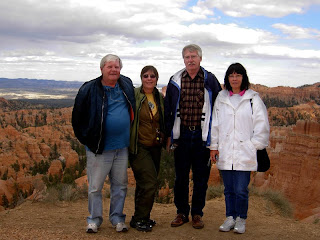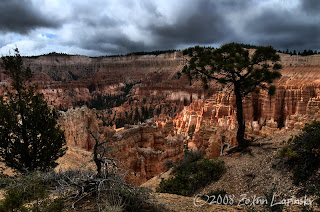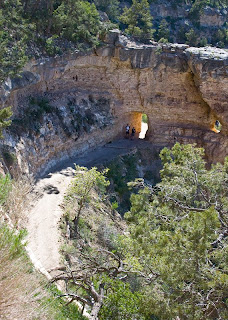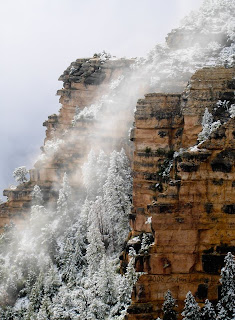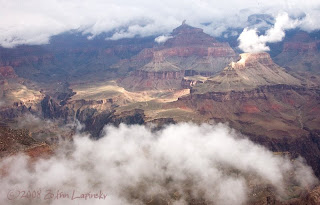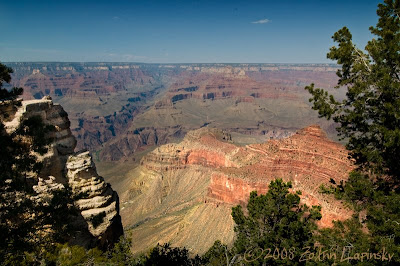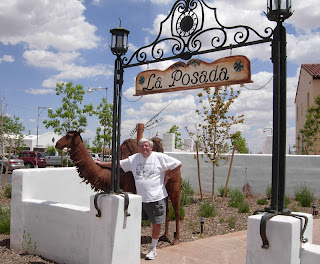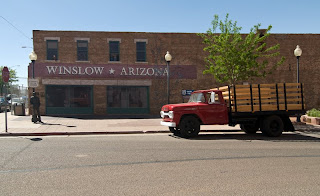Location: Grand Canyon, Bright Angel Trail, Sitting On A Mule
"You can train a horse to run off a cliff... a rider can't get a mule to do it. They are less likely to think that what you want is in their best interest."
---Casey Murph, Mule Operations Manager
A mule is the offspring of a horse mama and a jackass daddy. They look more like a horse, but don't act like one -- they are safest and happiest when they are not engaging in independent thinking, but are following along, closely behind the mule in front. When they are nose-to-tail they keep moving and aren't distracted by things like hikers, small animals, or a new rock that might have fallen on the trail since their last canyon trip and would need to be fretted over if they had time to contemplate it.
 The Grand Canyon offers two types of mule tours -- one is an overnight trip to Phantom Ranch, on the bottom of the canyon. Reservations are typically booked a year in advance. The other is a one-day, 12 mile round trip on the Bright Angel Trail, ending at Plateau Point. Since I didn't book Phantom Ranch last May, I went on the Plateau Point trip. Normally there are about 20 people on this one, but today there were 33 -- the trip to Phantom Ranch yesterday (the snow day) was cancelled because the mules were no longer shod in their "snow shoes," so many of those riders opted to join us on the one-day today. This photo of me at the trailhead was taken by one of the Phantom Ranch riders. See that narrow ledge down and to my right, between the two rows of lighter rocks? That's the trail the mules (and hikers) start down.
The Grand Canyon offers two types of mule tours -- one is an overnight trip to Phantom Ranch, on the bottom of the canyon. Reservations are typically booked a year in advance. The other is a one-day, 12 mile round trip on the Bright Angel Trail, ending at Plateau Point. Since I didn't book Phantom Ranch last May, I went on the Plateau Point trip. Normally there are about 20 people on this one, but today there were 33 -- the trip to Phantom Ranch yesterday (the snow day) was cancelled because the mules were no longer shod in their "snow shoes," so many of those riders opted to join us on the one-day today. This photo of me at the trailhead was taken by one of the Phantom Ranch riders. See that narrow ledge down and to my right, between the two rows of lighter rocks? That's the trail the mules (and hikers) start down.
 We met at 7:00 a.m. to hear what to expect physically (primarily knee pain, "elsewhere" pain, and fatigue) and to receive mule handling instructions. We were issued a "mule motivator" (crop) to keep them moving forward if they dawdle, and were assured that their hide is very tough and there is no way we can hurt them. The mules were all brought to a corral near the trailhead, and we were divided into three groups, each with two guides, one to lead us and one to bring up the rear. I was given a male mule named "Mister," and he turned out to be a very good mule indeed. He always kept close to the mule in front of him without any "motivating" from me, and only occasionally tried to grab a snack from vegetation along the trail. We got on the mules, a not-so-pretty sight in many cases (mine included) -- they are large animals, and many of us needed a "butt boost" to get in the saddle. But somehow we all got on, and started out.
We met at 7:00 a.m. to hear what to expect physically (primarily knee pain, "elsewhere" pain, and fatigue) and to receive mule handling instructions. We were issued a "mule motivator" (crop) to keep them moving forward if they dawdle, and were assured that their hide is very tough and there is no way we can hurt them. The mules were all brought to a corral near the trailhead, and we were divided into three groups, each with two guides, one to lead us and one to bring up the rear. I was given a male mule named "Mister," and he turned out to be a very good mule indeed. He always kept close to the mule in front of him without any "motivating" from me, and only occasionally tried to grab a snack from vegetation along the trail. We got on the mules, a not-so-pretty sight in many cases (mine included) -- they are large animals, and many of us needed a "butt boost" to get in the saddle. But somehow we all got on, and started out.
 This picture is the view of our destination shortly after we got on the trail. You may need to enlarge it to see the trail in the center of the green triangle -- the end of it is Plateau Point. The mules know the way -- they spend at least five years in training, carrying supplies and trainers, and then they are evaluated for temperament before they are allowed to carry paying guests. They make this trip every day, and are sure-footed. They do tend to walk on the outside of the trail, but this was only scary for a short time. Once you go around a switchback or two, you realize that they know what they are doing.
This picture is the view of our destination shortly after we got on the trail. You may need to enlarge it to see the trail in the center of the green triangle -- the end of it is Plateau Point. The mules know the way -- they spend at least five years in training, carrying supplies and trainers, and then they are evaluated for temperament before they are allowed to carry paying guests. They make this trip every day, and are sure-footed. They do tend to walk on the outside of the trail, but this was only scary for a short time. Once you go around a switchback or two, you realize that they know what they are doing.
On the way down, we stopped for a bathroom break and to fill up our water canteens at Indian Gardens, 1.5 miles before Plateau Point. Then we got back on the mules for the trip across the plateau, where yellow, purple, white, and magenta flowers were blooming along the trail. We had a box lunch at Plateau Point, sitting on the rocks and watching the rapids of the Colorado River below. Then back on the mules once again for the trip home. When we stopped again at Indian Gardens, everyone was hosed down to stay cool -- the temperatures in the valley can be 20-30 degrees warmer than at the top and it was now quite warm -- a big change from the low of 26 degree last night on the rim!
Here are some additional images from the trip. Mouse over the image for more information:





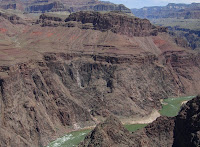





And, at the end of the trip, we were presented with a certificate welcoming us to the Order of the Master Mule Skinners of the Grand Canyon Trails. I then left the corral, walking stiffly, sorely, and a bit bow-legged, but not the least bit sorry that I went on this great adventure in the Grand Canyon, atop a good mule named "Mister." I'm just hoping that I'll be able to sit normally by tomorrow! 
 As we had planned months ago, I met Ken and Pam (see blog entries here and here) in Bryce, and my friend John is also here. The four of us hiked a loop trail in Bryce Canyon on Sunday, and then on Monday, Memorial Day, we hiked from the rim down to a small town named Tropic. Ken had lived there for a short time when he was a boy, and this was a hike he remembered fondly from his childhood. We began the hike in the morning, and within minutes a light snow started falling. How ironic -- we were hiking to a place named Tropic in the snow!
As we had planned months ago, I met Ken and Pam (see blog entries here and here) in Bryce, and my friend John is also here. The four of us hiked a loop trail in Bryce Canyon on Sunday, and then on Monday, Memorial Day, we hiked from the rim down to a small town named Tropic. Ken had lived there for a short time when he was a boy, and this was a hike he remembered fondly from his childhood. We began the hike in the morning, and within minutes a light snow started falling. How ironic -- we were hiking to a place named Tropic in the snow! The first indication that we were about to have a winter wonderland experience was when we saw the farthest hills and hoodoos softly fade into a misty white. Then the flakes began falling all around us as we navigated the switchbacks and trails going down from the rim. As we descended, the temperatures rose somewhat, and by the time we reached the bottom the snow had stopped, the sun was shining, and the temperature was pleasant. The rest of the hike was on flat terrain, through forests and shrubs, with the occasional sightings of chipmunks, lizards, and spring wildflowers.
The first indication that we were about to have a winter wonderland experience was when we saw the farthest hills and hoodoos softly fade into a misty white. Then the flakes began falling all around us as we navigated the switchbacks and trails going down from the rim. As we descended, the temperatures rose somewhat, and by the time we reached the bottom the snow had stopped, the sun was shining, and the temperature was pleasant. The rest of the hike was on flat terrain, through forests and shrubs, with the occasional sightings of chipmunks, lizards, and spring wildflowers.